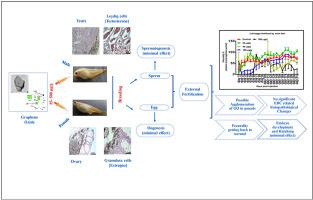Chemosphere ( IF 8.1 ) Pub Date : 2020-06-22 , DOI: 10.1016/j.chemosphere.2020.127221 Asok K Dasmahapatra 1 , Doris K Powe 2 , Thabitha P S Dasari 2 , Paul B Tchounwou 2

|
Due to its unique properties, graphene oxide (GO) has potential for biomedical and electronic applications, however environmental contamination including aquatic ecosystem is inevitable. Moreover, potential risks of GO in aquatic life are inadequately explored. Present study was designed to evaluate GO as an endocrine disrupting chemical (EDC) using the model Japanese medaka (Oryzias latipes). GO was injected intraperitoneally (25–200 μg/g) once to breeding pairs and continued pair breeding an additional 21 days. Eggs laid were analyzed for fecundity and the fertilized eggs were evaluated for developmental abnormalities including hatching. Histopathological evaluation of gonads, liver, and kidneys was made 21 days post-injection. LD50 was found to be sex-dependent. Fecundity tended to reduce in a dose-dependent manner during early post-injection days; however, the overall evaluation showed no significant difference. The hatchability of embryos was reduced significantly in the 200 μg/g group; edema (yolk and cardiovascular) and embryo-mortality remained unaltered. Histopathological assessment identified black particles, probably agglomerated GO, in the gonads of GO-treated fish. However, folliculogenesis in stromal compartments of ovary and the composition of germinal elements in testis remained almost unaltered. Moreover, granulosa and Leydig cells morphology did not indicate any significant EDC-related effects. Although liver and kidney histopathology did not show GO as an EDC, some GO-treated fish accumulated proteinaceous fluid in hepatic vessels and induced hyperplasia in interstitial lymphoid cells (HIL) located in kidneys. GO agglomerated in medaka gonads after 21-days post-injection. However, gonad histopathology including granulosa and Leydig cells alterations were associated with GO toxicity rather than EDC effects.
中文翻译:

评估氧化石墨烯对日本青鳉(Oryzias latipes)的生殖和发育影响。
由于其独特的性质,氧化石墨烯(GO)在生物医学和电子应用方面具有潜力,但包括水生生态系统在内的环境污染是不可避免的。此外,GO 对水生生物的潜在风险尚未得到充分探讨。本研究旨在使用日本青鳉 ( Oryzias latipes ) 模型来评估 GO 作为内分泌干扰化学物质 (EDC) 的作用。将 GO (25–200 μg/g) 腹腔注射一次给繁殖配对,并继续配对繁殖 21 天。对产下的蛋进行繁殖力分析,并对受精蛋的发育异常(包括孵化)进行评估。注射后21天对性腺、肝脏和肾脏进行组织病理学评估。发现 LD 50具有性别依赖性。在注射后的早期,生育力往往会以剂量依赖的方式减少;但总体评价并无显着差异。 200μg/g组胚胎孵化率显着降低;水肿(卵黄和心血管)和胚胎死亡率保持不变。组织病理学评估发现,经 GO 处理的鱼的性腺中存在黑色颗粒,可能是聚集的 GO。然而,卵巢间质室中的卵泡发生和睾丸中生发成分的组成几乎保持不变。此外,颗粒细胞和 Leydig 细胞形态并未表明任何显着的 EDC 相关效应。尽管肝脏和肾脏的组织病理学并未显示 GO 是一种 EDC,但一些经 GO 处理的鱼在肝血管中积聚蛋白质液体,并诱导位于肾脏的间质淋巴细胞 (HIL) 增生。注射后 21 天后,GO 在青鳉性腺中聚集。 然而,性腺组织病理学(包括颗粒细胞和间质细胞改变)与 GO 毒性相关,而不是与 EDC 效应相关。











































 京公网安备 11010802027423号
京公网安备 11010802027423号